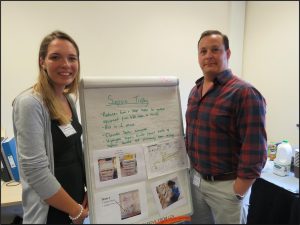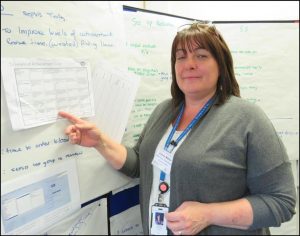 Sepsis patients at Shropshire’s two acute hospitals are receiving life-saving medication faster than ever before.
Sepsis patients at Shropshire’s two acute hospitals are receiving life-saving medication faster than ever before.
Using Virginia Mason Institute methodology, staff at The Shrewsbury and Telford Hospital NHS Trust (SaTH) have proved it is possible to give patient all elements of the ‘Sepsis 6’ bundle in less than an hour.
Evidence shows that completion of the ‘Sepsis 6’ bundle within one hour of provisional diagnosis increases survival rates. Prior to last week’s Rapid Process Improvement Week (RPIW), which took place on the Surgical Assessment Unit (SAU) at the Royal Shrewsbury Hospital, it was taking five hours.
Sister Andrea Walton, Process Owner of the second RPIW for the Sepsis Value Stream, said: “We were challenged to improve the processes for Sepsis patients on SAU by providing our patients with treatment and delivery of the Sepsis 6 bundle in a timely and consistent manner.
“Reducing the time it took to give a patient the Sepsis 6 bundle by so much an exceptional result and one we have pledged to ensure is sustained.”
The team involved in the RPIW achieved the results by reducing waste, such as the time it took looking for parts and walking to get equipment, and totally eliminating quality defects, such as patients not having a standardised plan of care for delivery of the Sepsis bundle.
The results have only been achieved on a small number of patients to date, all on SAU, but going forward the Trust plans to continue testing the changes by measuring results on a monthly basis.
Sister Walton said: “By taking a blood trolley and converting it into a Sepsis trolley, that not only had everything needed to deliver the bundle but also came with a folder that clearly outlined with visuals exactly where everything was kept, we stopped staff from having to walk around the ward looking for equipment and various other parts.
 “We also made the drip stand part of the trolley and that has resulted in the administration of intravenous antibiotics happening much quicker.
“We also made the drip stand part of the trolley and that has resulted in the administration of intravenous antibiotics happening much quicker.
“Markings have been clearly placed on the floor of the ward to ensure the trolley is always kept in the same place and ensuring stock is kept at correct levels in now easier than ever before.”
She added: “Such ideas may sound straight forward but when you are busy doing the day job you don’t always have the time needed to stand back and say ‘why don’t we do this?’ The five day RPIW was really hard work but also extremely rewarding when you see the results.”
The creation of a Sepsis trolley means the number of steps taken by a nurse to provide intravenous antibiotics to a patient on SAU has been reduced by 62 per cent (from 173 to 65) and the number of steps taken by a doctor from the diagnosis of a Sepsis patient to completion of prescriptions has been reduced by 57 per cent (from 235 to 100).
Sepsis arises when the body’s response to an infection injures its own tissues and organs. It leads to shock, multiple organ failure and death, especially if not recognised early and treated promptly. There are around 150,000 cases of Sepsis in the UK every year and approximately 44,000 deaths.
The UK Sepsis Trust developed the concept of the Sepsis Six bundle – a set of six tasks including: oxygen, cultures, antibiotics, fluids, lactate measurement and urine output monitoring to be instituted by non-specialist practitioners at the front line.
